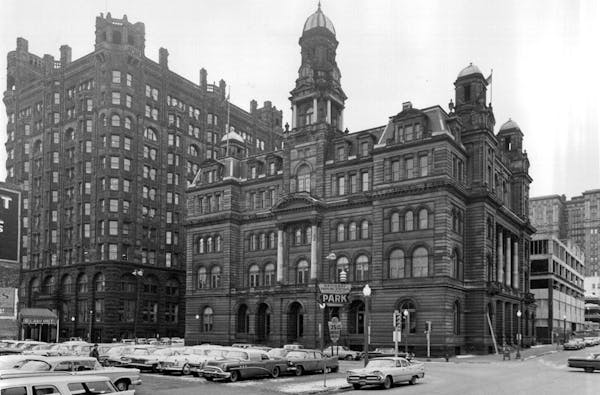One of the more curious buildings in the history of downtown Minneapolis started life as a roller-skating rink. It soon morphed into an outsized furniture store. Along the way, it joined up with a 12-sided architectural oddity to become a unique retail complex.
It began in 1884 at the northwest corner of 6th Street and Marquette Avenue, where the Westin Hotel (formerly the Farmers and Mechanics Bank) now stands.
In November of that year, two Minneapolis businessmen opened a large roller rink that also served as an exposition hall capable of seating up to 4,000 people. The two-story brick building supported a central gable along 6th, but otherwise offered little in the way of architectural adornment. It opened as the Crocker Roller Skating Rink.
A brief dive into old Minneapolis city directories reveals that its namesake was almost surely Frank L. Crocker, who conveniently owned a firm that manufactured roller skates. But a man named W.H. Leland was listed as the proprietor, suggesting the two were partners in the enterprise. By 1886, however, Leland was the man in charge and the facility assumed his name.
The rink was built at a time when roller skating was immensely popular, to the point of being a mania. By 1885, there were 11 rinks in Minneapolis and four in St. Paul. The Crocker-Leland establishment may have been the most elaborate of the lot.
Among the appeals of roller skating was that it offered boys and girls a chance to meet and mix. This, of course, led to periodic denunciations of roller skating from the pulpit by ministers worried that the youngsters might be having too much fun for their own good.
"There are more people in the rinks than attend church on Sunday," one newspaper writer groused, and that situation no doubt contributed to the ministerial wrath.
It appears the skating craze peaked around 1885. By the end of the decade many of the rinks had either been torn down or were repurposed.
From rink to furniture
We tend to think of building reuse as a fairly recent phenomenon inspired by the historic preservation movement that began in the 1970s. In fact, buildings often went through multiple uses in 19th-century Minneapolis. The Crocker-Leland rink was no exception.
In 1887, as the skating fad dimmed, the New England Furniture and Carpet Co., founded by a businessman from Boston, bought the rink and announced plans to turn it into what the Tribune described as a "mammoth emporium."
By then the rink was also called the Casino Building.
How it acquired that name isn't known, since gambling was then illegal (although quite commonplace) in the city of Minneapolis.
The building's appeal to the New England Co. was its sheer volume. The Tribune noted that the rink's capacity was "equal to a seven-story, 25 x 160 [foot] building," which gave the store a huge amount of room to display its stock.
The company made only modest changes to the rink's interior before opening its store. The exterior, however, was plastered with a dizzying array of signs, including two corner sign towers, lest anyone forget the name of its new occupant.
As it turned out, even the former rink wasn't big enough for the furniture store, which gradually expanded into adjoining buildings on 6th Street and to the north on Marquette Avenue.
The most interesting of these additions was the Panorama Building. The 12-sided brick structure was built in 1886 at 5th and Marquette to display "The Battle of Atlanta," an enormous Civil War panorama (also known as a cyclorama) created by a team of artists under the direction of a Milwaukee entrepreneur named William Wehner.
Viewed from a platform in the center of the building, the panorama opened on June 28, 1886, and initially drew as many as 12,000 visitors a week, at 50 cents a head. But the gigantic painting-in-the-round didn't prove to be a durable attraction, nor did a "Battle of Gettysburg" panorama that opened in 1887 in St. Paul and closed just two years later. The Minneapolis exhibit was shut down in 1889, although the panoramic painting survived and is now on display at the Atlanta History Center.
Banking on a future
The New England company took over the Panorama Building in 1893 and filled it with everything from carpets to comforters to stoves and heaters. Unfortunately, there are no photographs of the Panorama Building's interior, but it must have been a peculiar venue for the sale of home furnishings.
By the early 20th century, New England Furniture was one of downtown's biggest retailers, its store extending for a full block along Marquette. Progress, however, was on the way.
Plans were afoot for Minneapolis' first Federal Reserve Bank, designed by none other than Cass Gilbert, the architect who designed the Minnesota State Capitol.
The Panorama Building was demolished to make way for the bank, which was completed in 1924. (The bank, greatly enlarged and much remodeled, is known these days as the 510 Marquette Building.)
The rest of the New England complex came down not long thereafter. The site of the old skating rink was then used as a parking lot until the new Farmers and Mechanics Bank building opened in 1941.
Meanwhile, New England Furniture relocated to what is now the Kickernick Building at 5th Street and 1st Avenue N. Later, its main store was at 8th and Marquette, in a four-story building razed in 1969 to make way for the IDS Center.
I'm not sure what happened to New England Furniture after that, but I have to believe it would have been great fun to wander through their cavernous old store, amid the ghosts of roller skaters and panoramic painting, and maybe look for a nice down comforter.
Larry Millett is an architecture critic and author. He can be reached at larrymillett.com.











